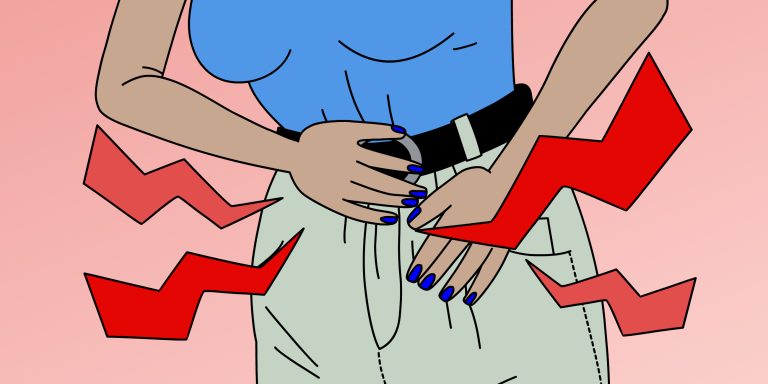
Endometriosis Stages: Minimal, Mild, Moderate & Severe, What To Expect With Each
Endometriosis is a medical condition that occurs when the lining of the uterus — the endometrium — grows outside of the uterus. Growth can occur anywhere in the abdominal region and even elsewhere, but predominantly appears on the fallopian tubes, ovaries, and pelvis. Eventually, the lining breaks down — as it would do in the uterus — however, menstruation has nowhere to go, creating serious health risks.
Women who are diagnosed with Endometriosis typically report abdominal pain, abnormal period pain, pain with sexual intercourse, or infertility as their first symptoms. However, it is also possible for women to feel no symptoms at all, and still have Endometriosis.
Endometriosis is estimated to affect between 3-10% of reproductive-aged women, and can often only be diagnosed with a laparoscopy, which is when a doctor surgically evaluates the abdomen with a camera inserted through the belly button, thus making them able to take a sample of the lining to confirm. Most women find out about Endometriosis either from abnormal or extreme pelvic pain during their period or otherwise throughout their cycle, or after being tested for infertility.

There are actually four stages of Endometriosis, and each comes with its own classifiable issues and symptoms. Understanding the stages are essential for health and care.
The Stages of Endometriosis
According to WebMd, there are four stages of Endometriosis that are accepted by the medical community. They are as follows:
Stage 1 — Minimal
At stage 1, there are a few small implants, growths, wounds or lesions on the organs or otherwise found in the abdomen. At this point, there is little to no scar tissue visible, and pain is mild, though often detectable.
Stage 2 — Mild
At stage 2, the implants and lesions are distinctly more well-developed than at stage 1, however, at this point, they are also more deeply embedded in the tissue, and some scar tissue may begin to be visible. At this point, pain is typically more pronounced, though still not as extreme as later stages.
Stage 3 — Moderate
At stage 3, there are multiple implants and lesions, that are often producing cysts on ovaries, and bands of scar tissue, called adhesions. At this point, the pain is significantly interfering with day-to-day functionality, and may be causing other serious health complications, such as infertility.
Stage 4 — Severe
At this point, the Endometriosis is as widespread as it can be. There are multiple implants, adhesions and scarring. The pain is significant and can seriously interfere with one’s ability to function. Cysts on one or both ovaries are also likely.
The Types of Endometriosis
Along with the stages of Endometriosis, there are also different types of the disease as well. They are as follows.
Superficial Peritoneal
With this version of Endometriosis, the peritoneum, which is a thin membrane that lines your abdomen and pelvis, is being impacted by the endometrial tissue. This is the least severe form of Endometriosis, as the tissue is not yet impacting organs or muscle groups. Be that as it is, this type of Endometriosis can still be very painful and require medical intervention.
Endometriomas
This is when dark, fluid-filled cysts are found in different parts of your abdomen. (They are sometimes called ‘chocolate cysts.’) At this point, the cysts can vary in size and appear not only on your ovaries, but other areas as well, such as your pelvis or abdomen. This is still classified as Endometriosis, though the issue is predominantly with cystic growth, rather than lining.
Deeply Infiltrating
This is the type of Endometriosis wherein the endometrial tissue has invaded the organs in or around the pelvic cavity. This can include but is not limited to ovaries, rectum, bladder and bowels. This type of Endometriosis is generally considered one of the more severe cases, and can present possible health complications for the impacted areas of the trunk. In some cases, excessive scar tissue can “bond” organs together, and make them stuck. This is called “frozen pelvis,” but generally only impacts 1-5% of those diagnosed.
Abdominal Wall
Finally, abdominal wall Endometriosis is when endometrial tissue grows on the abdominal wall as opposed to organs or organ groups. At this point, cells from the tissue can attach to the wall through a surgical incision, such as a C-Section scar. At this point, the lining and scar tissue grows and develops around the scar, creating pain, discomfort, and other potential health concerns.

Testing for Endometriosis
There are a number of ways that doctors can test for endometriosis. First, they will likely perform a pelvic exam, during which the doctor will manually feel areas of the pelvis for any growths or abnormalities. However, this can be ineffective because it can be difficult to feel any abnormalities if they are not advanced, or if they have not already caused cysts.
Next, you can diagnose through an ultrasound, which is a high-frequency sound wave technique that creates images of your organs. It’s typically used throughout pregnancy, to monitor the development of a fetus. Again, it might not always be effective at identifying tissue as it is cysts, or other larger growths.
Last, doctors might rely on an MRI or a laparoscopic exam. The MRI will give detailed images of the body’s organs and tissues, and will likely be necessary if you are going to undergo surgery to remove tissue. The MRI will give the most detail without having to actually open your body. Another option is a laparoscopy, in which the surgeon will actually take a tissue sample from inside your body to confirm endometriosis.
Treating the Different Types of Endometriosis
Right now, there is not any one cure for endometriosis, WebMd reports, but there are still ways to treat and manage one’s symptoms.
First, patients with endometriosis will likely be prescribed a pain medication for discomfort. This can come in the form of an NSAID, which is a stronger medication. Second, patients can be recommended for hormone therapy, which can either stop your menstrual period, or make areas affected by endometriosis bleed less heavily. Hormone therapy can also reduce inflammation, and make scars and cysts less likely. This can come in the form of birth control.
If none of these options are viable or effective, it is also possible to have surgery to remove some of the misplaced tissue. In more extreme cases, some women opt to have a full or partial hysterectomy — a removal of their reproductive organs — which would provide permanent relief. However, this is not suggested for women who still want to have children, as it would make reproduction impossible, save for freezing one’s eggs and utilizing a gestational carrier.










